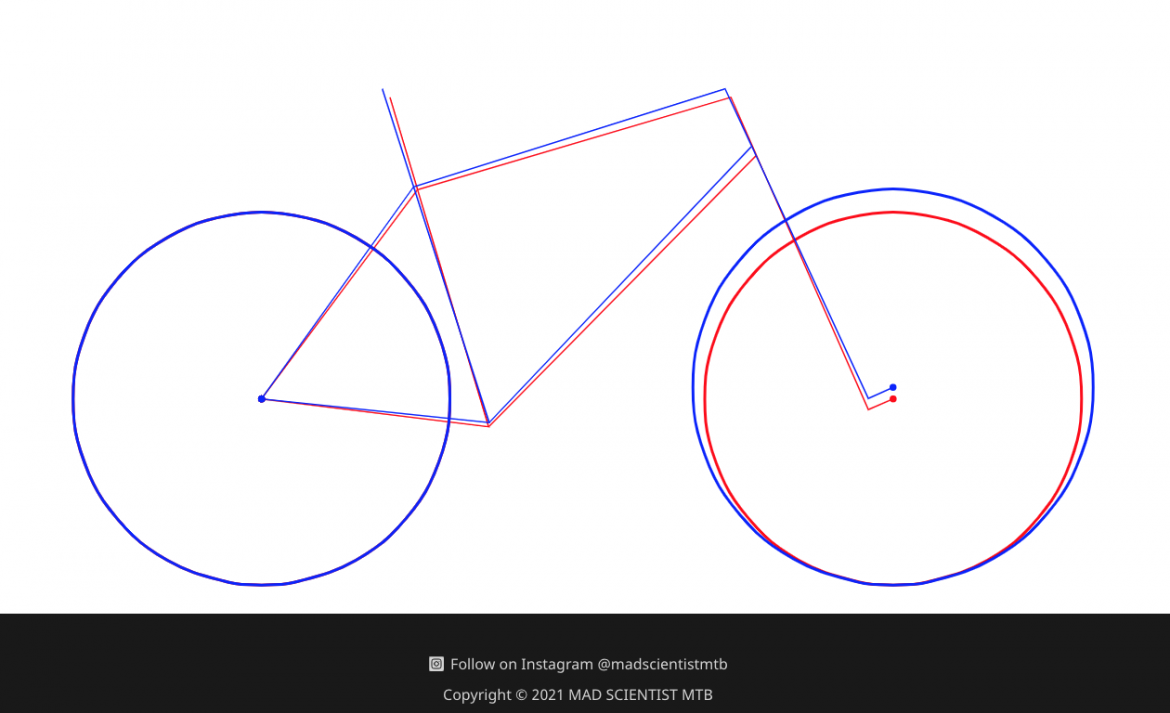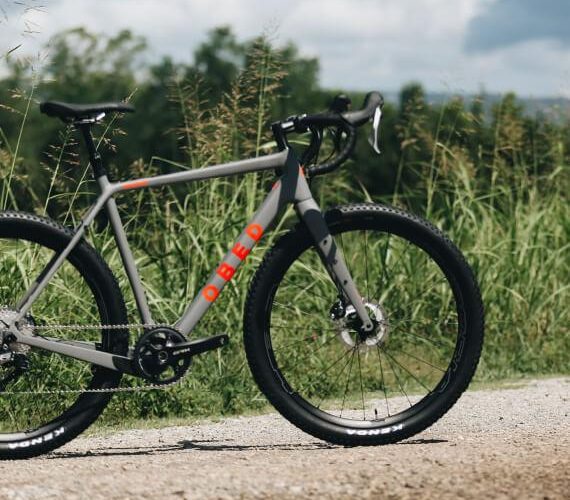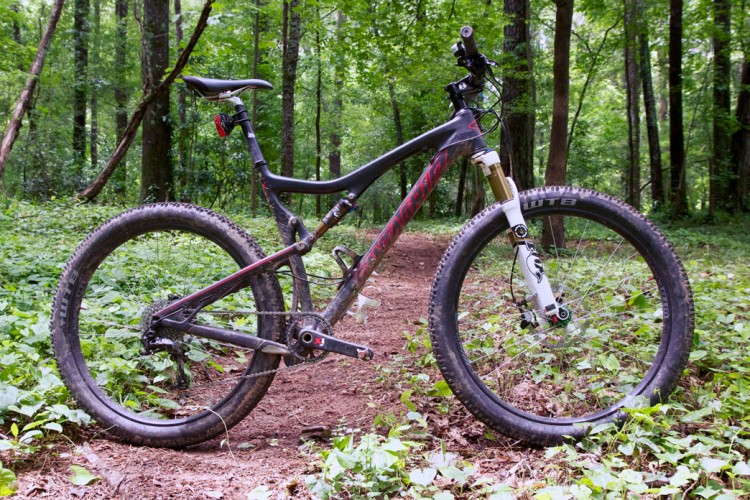
With 2022 mountain bike models nearly impossible to find at the local bike shop, many riders are looking to get another year or two out of their current bike. Mixed-wheel bikes are seemingly all the rage at the moment, and it’s technically possible to convert an existing bike to mixed-wheel with just a couple key component swaps. So is it worthwhile? Well, here are some important things to consider.
Progressive (and regressive) geometry
Unless your bike frame has a flip chip, its geometry is pretty much set. Mountain bike geometry has proven to be incredibly progressive over the years, and out-of-favor angles and measurements are often one of the key reasons for an upgrade. Taking a matched-wheel bike and mixing things up will change the bike’s geometry, so it’s potentially an easy way to get some of the angles and measurements you’re looking for.
For all the geometry comparisons below, I’ll be using results from the Mad Scientist MTB geometry calculator. Whether you’re starting with a 29er or a 27.5″ bike, the geometry changes will be fairly similar and should only vary slightly in magnitude depending on the tire size you select for your build. I decided to use 27.5×2.4″ and 29×2.6″ tires for my calculations so if you’re using something different and want a more accurate picture of what that means in terms of the angles and measurements you’ll want to run the numbers yourself.
The initial geometry of your bike frame will also make a difference in terms of the size of the changes, though it should still be pretty similar to what I outline here. Also, this analysis assumes the fork’s axle to crown length remains roughly the same between builds. (More on that later.)

Head tube angle (HTA) ✅
Starting with either a 27.5″ or 29er bike, converting to mixed wheel will generally slacken the head tube angle by about a degree, give or take. I plugged in the geometry for two different hardtails, each with a 66.5° head tube angle, and with a mixed-wheel setup, both HTAs landed just below 65.5°. In terms of progressive geometry (longer, lower, slacker [LLS]), a slacker head tube angle is moving things in the right direction, and a full degree of change can be significant.
Seat tube angle (STA) ❌
The latest mountain bikes are seeing ever-steeper seat tube angles, so much so that perhaps we should amend LLS to LLSS. On this front, the seat tube angle is actually going to become slacker, not steeper, by exactly the same amount as the head tube angle. Remember, the frame isn’t changing, it’s only being rotated with one of the axles serving as the pivot point.
What does this mean? If your matched wheel bike isn’t great on climbs, mixing the wheels is going to make it even worse. On the flip side, if it climbs well enough but suffers on the descents, a wheel change could make sense.
Reach ❌
The “longer” part of the LLS equation generally refers to reach, and on this front, unfortunately, it’s bad news for progressive geometry as well. In both cases — starting with a 29er or 27.5″ wheel — the reach is going to get shorter as the head tube tilts rearward. However, if a bike already feels too large in terms of fit, a shorter reach could make it more comfortable. Looking at a the numbers on a couple different bikes, going mixed wheel reduces reach by about 12mm, which can be the difference in geometry from one model year to the next. This is one area where you’ll likely be setting your bike back in time.
Bottom bracket (BB) height 🤔
On bottom bracket height, the outcome is… mixed (get it?). The other ‘L’ in LLS, lower bottom brackets have been in favor for several seasons now due to the added stability they tend to offer. Of course, too low and pedal strikes become an issue, not to mention log and rock hops require more oomph. Still, assuming a lower bottom bracket is a good thing, then starting with a 29er and going mixed wheel delivers the goods with about a 14mm decrease. Going from 27.5″ to mixed wheel increases the BB height by less, at about 8mm.
Rather than focusing on the BB height change, it’s probably better to focus on the absolute number. Looking at a sample of current hardtail mountain bikes on the market, BB heights range from 296mm to 333mm (FS bikes are slightly trickier since you’ll need to take sag into account). The bikes I analyzed both fall well within this range after mixing wheels so they are good candidates, at least on this front.
If the mulleted BB height is outside this range, that can be a red flag. Depending on whether you’re happy with your current BB height or not, going higher or lower could be an improvement or a downgrade. There’s not a right answer here, and clearly, the decision requires a judgment call.
Stack height
Going from matched to mixed wheels will increase the bike’s stack height (about 8mm for the conversions I considered). This generally affects fit a bit more than performance, so be sure to read the bike fit section below.

In the end it may be possible to minimize, or even eliminate, some of the geometry changes listed above through various methods. For example, with a 27.5″ bike conversion, going to a shorter-travel, 29er fork could allow you to maintain much of the original geometry. There are other geometry hacks that can be employed as well, including angle- and reach-adjust headsets, fore or aft seat post heads, eccentric BB cups, tire size variations, shorter/longer cranks, and shock link swaps, just to name a few. Each of these solutions introduce their own set of tradeoffs, and with so many possible combinations, you’ll need to focus on solving (or simply living with) the issues that matter most to you.
Ride feel
In general, 29er wheels are known to offer a smoother ride thanks to improved rollover ability, and they provide better momentum compared to smaller diameter wheels. On the flip side, 27.5″ wheels are said to be more maneuverable, are generally lighter-weight, and are require less energy to accelerate.
Depending on where you’re starting — with a 29er or 27.5 bike — these ride characteristics will cut in one direction or another. So, a 29er will feel a bit snappier and lighter as a mixed wheel bike, but you’ll likely also notice more bumps in the trail and won’t be able to coast as freely. And vice versa.
Since the head tube angle is slackened on a mixed-wheel conversion, there’s a good chance the steering will also feel a little slower.
Bike fit
Mixing wheels will certainly affect the bike fit, particularly when it comes to the reach and stack height numbers. To compensate, riders may need to adjust the saddle position and consider swapping the stem length and adjusting the number of spacers above and below the stem. Many of the geo-adjust hacks mentioned previously can apply to bike fit as well.
Mulleting a 29er
Back in 2015 I decided to mix wheels on a first-generation Santa Cruz Tallboy 29er. Instead of a regular 27.5″ rear, however, I used a 27.5+ which wasn’t as dramatic a change in terms of wheel sizing, but it still made a noticeable improvement in the ride feel and allowed me to get another season or two out of a bike that I had out-progressed.

Mixing wheels on a 29er is the easier of the two options in that you really only need to buy a single 27.5″ rear wheel and tire. Obviously, you’ll want to make sure the hub spacing and driver body match the existing wheel, and that the brake setup will work too. There will be a good bit of extra frame clearance with the smaller rear wheel which might look odd, but at least it should clear mud well and may even allow you to fit a wider tire than before. Another advantage, especially for smaller riders, is the potential for more butt clearance over the rear tire on steep descents.
For the calculations used above, I considered my own beloved Orange P7 hardtail from 2018. The bike has seen a geometry update or two since then so I was curious to see how close I could get to the latest and greatest geometry with a smaller rear wheel. Going mixed wheel gets the HTA close (65.4° for mixed wheel vs. 65° for current 29er model) and the STA isn’t too far off (73° vs. 74°). Where the whole thing falls apart is the reach; mixing wheels would make the bike way too short for my comfort. Fortunately, I’m still really happy with how the 2018 bike rides so I’ll be keeping it 29er for the foreseeable future.
How much would it cost? The swap can be done for about $250 ($200 for a new wheel, $50 for a tire).
Mulleting a 27.5
I’ve been testing the Thomson Hooch for several weeks now, both as a 27.5″ and also as a mixed-wheel bike. After popping a 29er fork and wheel on the front, I found a fairly dramatic improvement in the ride feel, though sadly not the fit. If I owned this bike, I would very seriously consider mixing the wheels.

However, going this direction could be pricey since for most bikes it will involve upgrading to a longer 29er fork in addition to the wheel and tire change.
How much would it cost? $750 or more for a fork and wheel swap ($500 fork, $200 wheel, $50 tire).
What about mixing other wheel sizes?
It’s definitely possible to mix other wheel sizes too, for example slapping a 27.5″ fork and wheel on an old 26er. Mixing 26″ and 29″ wheels is possible too, though keep in mind all of the changes outlined above will be amplified. It’s a good idea to run your bike’s numbers using this online tool and decide based on how those changes will affect the ride feel and fit, both positively and negatively.
The bottom line is, mixing wheels on an existing bike does have its benefits as well as its drawbacks. As a part of the decision making process, I suggest answering the following questions honestly:
- Do I want the bike to be a more aggressive descender?
- Does the bike currently climb well?
- Will a [higher or lower] bottom bracket be an improvement?
- Is the bike’s reach currently too long for me?
- Am I more comfortable putting the money into upgrading this bike rather than buying a new one?
- Will it be possible to get a reasonable fit in the end?
If you answer yes to most or all of these questions, then a mixed wheel conversion is likely a good fit for you. Have you converted a bike to mixed wheel? Tell us about it in the comments!





















6 Comments
Sep 15, 2021
I often get asked why somebody would choose to mullet a bike and honestly I don't ever have great answers. It seems like a solution in search of a problem sometimes! But hey, I'm always up to do some experimenting and it's fairly cheap to do, especially if you have a spare wheel kicking around or a nice friend to donate one for a bit. I've done it on a 27.5+ hardtail running 27.5x2.8 on the rear and 29x2.6 in front and also awhile back on a 26 full suspension running a 27.5 front. In both cases I couldn't get along with the shortened reach and slacker seat tube angle. I find an angleset is a much better way to breathe some life into an older ride.
Justin White, I want to clarify something in response to your comment. The stack will increase when you change either wheel. The stack is defined as the vertical distance between the bottom bracket and the top of the headtube. If you use a smaller rear wheel you'll lower the bottom bracket quite a bit and lower the head tube just a bit, since the bike is rotating counterclockwise about the rear wheel's contact point, so the vertical distance between bottom bracket and top of head tube will increase even though the head tube ends up a bit lower relative to the ground.
You could have two bikes with the same top of head tube height but the bike with the lower bottom bracket will have the taller stack because of how the stack measurement is defined. Hope that clears it up!
Sep 13, 2021
This of course is all rehashed experimental tinkering from the Pacenti years - a worthy exercise of course, but ultimately leading to the purchase of a different bike all together. ;)
Sep 15, 2021
Stack would increase only when putting a 29 fork and front wheel on a full 27 will increase the stack. The opposite, 27 rear wheel on a full 29 will not increase stack, even your graphics demostrate this.
Sep 16, 2021
Sep 19, 2021
One thing I cannot stand is towering over my bars and feeling shoved up under the freakin stem. Steep STA's are a no go in my stable however, other folks enjoy it.
Mullet is nothing new... Cannondale did it decades ago with 26/24. Now, we ave some wheel choices that didn't exist at that time and folks experimenting with mullet are doing something called having fun playing with bikes cause bikes are ageless toys for the masses, especially those with imagination.
Next bike will be started after the CAD file is complete and the tig is prepped to glue it all together.
Dec 30, 2021